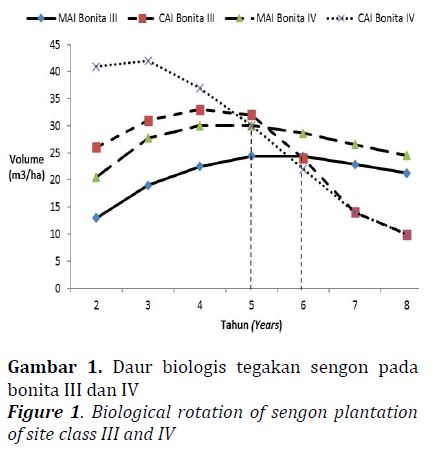Daur Optimal Hutan Tanaman Sengon Dalam Proyek Aforestasi: Review Hasil Penelitian Suharlan 1975

Downloads
Forests play an important role in climate change mitigation by absorbing carbon dioxide in the atmosphere. Additional revenue from carbon credits may change the optimal management of plantation forest. This research aims to analyze the optimal rotation of joint production of timber and carbon sequestration of sengon stand in Java. The method used in this research is the profit maximization of forest stand obtained from wood sales and carbon credits (i.e. Hartman rule as a modification of Faustmann rule). The results of this study showed that (1) the biological rotation of sengon forest in site quality (SQ) III and IV are 6 and 5 years respectively, (2) Financial rotations of sengon forest in SQ III and IV are 8 and 6 years respectively, and (3) Additonal income from carbon sales in afforestation project will not lengthen the optimal rotation of sengon plantation.
Amacher, G. S., Ollikainen, M., & Koskela, E. (2009). Economics of forest resources. Cambridge, Mass.: MIT Press.
Asante, P., & Armstrong, G. (2016). Carbon sequestration and the optimal forest harvest decision under alternative baseline policies. Canadian Journal of Forest Research, 656-665. doi: 10.1139/cjfr-2015-0222
Asante, P., & Armstrong, G. W. (2012). Optimal forest harvest age considering carbon sequestration in multiple carbon pools: A comparative statics analysis. Journal of Forest Economics, 18(2), 145-156. doi: http://dx.doi.org/10.1016/j.jfe.2011.12.002
Asante, P., Armstrong, G. W., & Adamowicz, W. L. (2011). Carbon sequestration and the optimal forest harvest decision: A dynamic programming approach considering biomass and dead organic matter. Journal of Forest Economics, 17(1), 3-17. doi: DOI 10.1016/j.jfe.2010.07.001
Bettinger, P., Boston, K., Siry, J. P., & Grebner, D. L. (2009). Forest management and planning. Burlington USA: Academic Press.
Binkley, C. S. (1987). When is the optimal economic rotation longer than the rotation of maximum sustained yield? Journal of Environmental Economics and Management, 14(2), 152-158.
Bravo, F., Jandl, R., LeMay, V., & Gadow, K. v. (2008). Introduction. In F. Bravo, R. Jandl, V. LeMay & K. v. Gadow (Eds.), Managing forest ecosystems: The challenge of climate change (Vol. 17): Springer.
Galinato, G. I., & Uchida, S. (2011). The effect of temporary certified emission reductions on forest rotations and carbon supply. Canadian Journal of Agricultural Economics/Revue canadienne d'agroeconomie, 59(1), 145-164. doi: 10.1111/j.1744-7976.2010.01203.x
Hartman, R. (1976). Harvesting decision when a standing forest has value. Economic Inquiry, 14(1), 52-58.
Indrajaya, Y. (2013). Penentuan daur optimal hutan tanaman sengon (Paraserianthes falcataria (L.) Nielsen) dengan metode Faustmann. Jurnal Penelitian Agroforestry, 1(1), 31-40.
Indrajaya, Y., & Astana, S. (2016). Daur optimal tegakan gmelina pada dua proyek karbon: Memperpanjang daur dan aforestasi. Jurnal Penelitian Sosial dan Ekonomi Kehutanan, 13(3), 145-154.
Indrajaya, Y., & Siarudin, M. (2013). Daur finansial hutan rakyat jabon di Kecamatan Pakenjeng, Kabupaten Garut, Jawa Barat. Jurnal Penelitian Hutan Tanaman, 10(3), 201-211.
Indrajaya, Y., & Siarudin, M. (2015). The effects of carbon payment on optimal rotation of Gmelina forests. Paper presented at the INAFOR 3, Bogor, Indonesia.
Indrajaya, Y., & Sudomo, A. (2015). Pengaruh tambahan pendapatan jasa lingkungan karbon terhadap daur optimal tegakan manglid di Jawa Barat. Paper presented at the AFOCO Workshop "Pengembangan mata pencaharian alternatif untuk masyarakat lokal dalam upaya menghadapi dampak perubahan iklim", Bogor.
IPCC. (2006). IPCC Guideline 2006 Guidelines for national green house gas inventories: IPCC.
Kindermann, G., Obersteiner, M., Sohngen, B., Sathaye, J., Andrasko, K., Rametsteiner, E., . . . Beach, R. (2008). Global cost estimates of reducing carbon emissions through avoided deforestation. Proceedings of the National Academy of Sciences of the United States of America, 105(30), 10302-10307. doi: DOI 10.1073/pnas.0710616105
Kementerian Kehutanan (2009). Peraturan Dirjen Bina Produksi Kehutanan No P.13/VI-BPPHH/2009, tentang Rendemen Kayu Olahan Industri Primer Hasil Hutan Kayu (IPHHK) (2009).
Köthke, M., & Dieter, M. (2010). Effects of carbon sequestration rewards on forest management—an empirical application of adjusted Faustmann formulae. Forest policy and economics, 12(8), 589-597.
Krisnawati, H., Adinugroho, W. C., & Imanuddin, R. (2012). Model-Model Alometrik untuk Pendugaan Biomassa Pohon pada Berbagai Tipe Ekosistem Hutan di Indonesia (Indonesia versions): wahyu catur adinugroho.
Krisnawati, H., Varis, E., Kallio, M., & Kanninen, M. (2011). Paraserianthes falcataria (L.) Nielsen. Ekologi, Silvikultur dan Produktivitas. Bogor Indonesia: CIFOR.
Olschewski, R., & Benitez, P. C. (2010). Optimizing joint production of timber and carbon sequestration of afforestation projects. Journal of Forest Economics, 16(1), 1-10. doi: DOI 10.1016/j.jfe.2009.03.002
Riyanto, H. D., & Putra, P. B. (2010). Model pertumbuhan tegakan hutan tanaman sengon untuk pengelolaan hutan. Tekno Hutan Tanaman, 3(3).
Sauter, P. A., Mußhoff, O., Möhring, B., & Wilhelm, S. (2016). Faustmann vs. real options theory – An experimental investigation of foresters’ harvesting decisions. Journal of Forest Economics, 24, 1-20. doi: http://dx.doi.org/10.1016/j.jfe.2016.01.004
Suharlan, A., Sumarna, K., & Sudiono, J. (1975). Tabel Tegakan Sepuluh Jenis Kayu Industri. Bogor: Pusat Penelitian dan Pengembangan Hutan.
Viitala, E.-J. (2016). Faustmann formula before Faustmann in German territorial states. Forest policy and economics, 65, 47-58. doi: http://dx.doi.org/10.1016/j.forpol.2015.11.004
Winjum, J. K., Brown, S., & Schlamadinger, B. (1998). Forest harvests and wood products: Sources and sinks of atmosphere carbon dioxide. Forest Science, 44(2), 272-284.
World Bank. (2013). World Bank Indicator. 1960-2013. Retrieved 10 February, 2014
Zanne, A. E., Lopez-Gonzalez, G., Coomes, D. A., Ilic, J.,, Jansen, S., Lewis, S.L., , Miller, R. B., Swenson, , N.G., W., M.C., , & Chave, J. (2009). Global wood density database.
Zhou, W., & Gao, L. (2016). The impact of carbon trade on the management of short-rotation forest plantations. Forest policy and economics, 62, 30-35. doi: http://dx.doi.org/10.1016/j.forpol.2015.10.008

